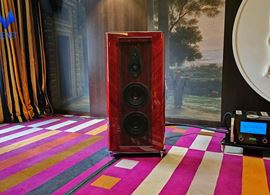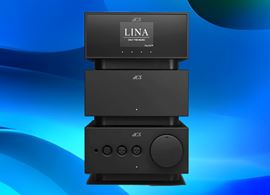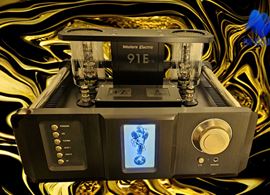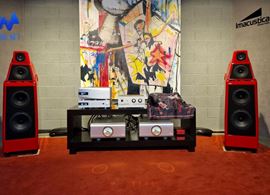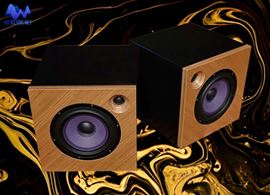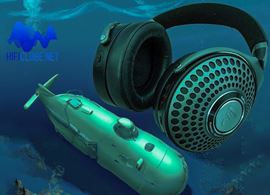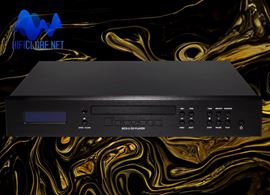The STAX SR-X9000 electrostatic earphones are the legendary Japanese brand's response to the success of planar magnetic headphones in today’s high-end audio landscape.
Once upon a time, electrostatic headphones bore a name: STAX. Nowadays, nearly a dozen manufacturers offer electrostatic models: Audeze, Dan Clark, Hifiman, Koss, Sennheiser, Shure and Warwick Acoustics. Most of these brands also delve into isodynamic models, a distinct transduction technology that sets them apart from STAX, a company exclusively focused on electrostatic headphones.
In my experience, no other electrostatic headphones match the sound quality of the STAX SR-X9000.
It's no secret that I'm a fan of isodynamic types, and, until now, not so keen on electrostatics. Therefore, I was intrigued when Sound & Pixel dared send me a pair of STAX SR-X9000 for testing, along with the SRM-700T amplifier (or “energizer”). Clearly, it shows full confidence in their product, and rightfully so. In my experience, no other electrostatic headphones match the sound quality of the STAX SR-X9000, which STAX aptly refers to as “earphones.” They are a fatal attraction to all audiophiles.
How does it work?
But let’s not get ahead of ourselves. Before diving into the unique aspects of the sound, let’s explore how these headphones work. First, I want to clarify that I will be relying on the same information provided by STAX to all the other critics. Therefore, don't expect any groundbreaking revelations here.
Rather than relying on conventional dynamic drivers to reproduce sound, STAX SR-X9000 electrostatic headphones employ an ultra-thin conductive membrane suspended between perforated plates charged with a high voltage (580 V). This is electrostatic technology, in a nutshell.

STAX SRM-700T, dedicated STAX electrostatic headphones hybrid amplifier (FET/valves).
When an audio signal reaches the plates, it creates a voltage difference that causes the membrane (also known as the diaphragm) to vibrate and produce sound. To achieve the required high voltage, a particular amplifier or energizer—as STAX refers to it—is essential. We will explore this topic momentarily.
The plastic membrane used in these headphones is incredibly thin and lightweight, resulting in instantaneous responsiveness to audio signals (no inertia). Consequently, listeners experience a sense of purity, speed, and exceptional clarity with minimal distortion or colouration.
However, this design choice can sometimes also lead to a perceived lack of body and power, especially in the lower frequencies. The open-back design of these headphones—lacking the resonance box found in closed headphones—partly contributes to their unique sound characteristics.
What is better: electrostatic or isodynamic?
The debate over the advantages of dynamic, electrostatic, and planar-magnetic (isodynamic) transduction technologies can be endless. In planar-magnetic technology, the ultra-thin diaphragm operates on a distinct magnetic principle. The signal is applied directly to a conductive circuit pattern that permeates the membrane. Driven by signal modulation, the membrane responds, either by being attracted or repelled by single or double arrays (push-pull) of neodymium magnets.
In my opinion, electrostatic headphones have a sound that lacks depth and richness, particularly in the lower frequencies, when compared to planar magnetic headphones. Planar magnetic headphones, on the other hand, seem to have a more balanced midrange and extended bass, but with a slightly harsher treble.
SR-X9000 to the rescue
Enter the SR-X9000, which employs Multi-Layer-Elect-Rords (MLER) fixed-electrode technology. Not only does this reduce resonances, but it also enhances sound transmission to our ears, resulting in the most impressive bass reproduction I’ve encountered in any electrostatic headphones. Period.
The SR-X9000’s diaphragm is 20 percent larger and thinner than its predecessor, the top-of-the-range SR-009. However, according to STAX, the most significant technological advancement in the SR-X9000 is the MLER-3 (Multi-Layer-Elect-Rords) fixed electrode design. This configuration combines four layers of fixed electrodes: mesh and conventional etching electrodes crimped together using thermal bonding to increase rigidity. The mesh undergoes further treatment to eliminate any unwanted resonances.
The light round aluminium capsules, reminiscent of the SR-Lambda (1979), ST-007 (1998), and SR-009 (2011), are now larger and comfortably accommodate my ears without causing discomfort, finally meeting the circumaural specification.
Notably, the diaphragm’s outer gold protection grille is meticulously mounted on pillars of varying sizes, effectively eliminating parallelism and the resulting reflections.

The geisha and the samurai: STAX SR-X9000+SRM-700T
Comfortably numb
The ear cushions provide an incredibly comfortable experience, featuring genuine lamb’s leather on the surface that meets the ears. Meanwhile, the remaining surface is crafted from artificial leather. The leather headband boasts a generous width to evenly distribute the headphones’ weight—remarkably light at just 432 gr. The outer stainless-steel band doubles as an adjustment spring, providing a gentle and comfortable clamping force.
The build quality of the SR-X9000 headphones is nothing short of exceptional, as expected from a high-end luxury niche cult product. These headphones come with a price tag of €7,490, and there’s an additional cost of nearly €4,000 for the dedicated valve amplifier. It is important to note that the SR-X9000 requires a polarisation voltage of 580V DC and cannot be powered by a conventional amplifier.
Encased in an elegant wooden box, the headphones arrive with two pairs of flat, flexible cables: one measuring 2.5 metres and the other 1.5 metres. These cables feature silver-plated 6N OFC pure copper conductors and 5-pin XLR plugs.
Sound & Pixel, STAX’s distributor for Portugal and Spain, sent me the SR-X9000s via the OnOff shop, bundled with the SRM-700T valve amplifier (energizer) priced at €3,995. The SRM-700T is a hybrid amplifier specifically designed for electrostatic headphones, seamlessly combining a solid-state FET stage with a valve output stage (6SN7).

STAX SR-X9000 were driven by the iFI iCAN Phantom and the STAX SRM700T. Both with excellent results.
Truth be told
I spent an extended period listening to music, using either the STAX SRM-700T or the the iFi iCAN Phantom to power the SR-X9000 headphones. The iFi iCAN Phantom is the only headamp that can be used with all types of headphones, including electrostatics.
Note: For a more detailed analysis of the iFI iCAN Phantom, you can read the full review here.
Electrostatic headphones are well-known for their transparency and expanded soundstage, which is also partially due to their open-back design. As a result, many audiophiles prefer to use them to listen exclusively to classical music or live jazz.
Currently, I am ecstatic while listening to sax player Connor Munroe's warm rendition of "Round Midnight," as I write. Before this, I listened to a beautiful rendition of Schubert's "Unfinished" 8th Symphony's "Allegro moderato" by the Saxon State Orchestra, Dresden, directed by Herbert Blomstedt. The string tone was mesmerizing, and the brass and drum rolling were menacing, something unusual with most electrostatics.
However, the SR-X9000 also delivers spectacular detail and harmonic nuances from just the sensual breathiness of a female vocalist and the plucking or heavy picking of guitar strings. A good example is ‘Fever’, by Friend ‘nd Fellow. Or a male vocalist, like Eric Clapton in ‘Man Of The World’.
The SR-X9000s never felt intimidated in the presence of electronic music, even with devilishly pulsating low frequencies. Listen to ’Hackers’ by Metrik and feel the bass resonate with authority, shaking your soul, if not your body—we are talking about earphones, not loudspeakers. Just in case, buckle up to enjoy the drum & bass vibes!
Would you like to listen to something that is both simple and elaborate? I recommend giving Mina Agossi's 'Twisted' a try. You'll enjoy the interplay of her smoky voice, along with the percussion and bass that punctuate the rhythm. The synthesiser in the background adds to the mystery, while you can still analyse the chaotic jazz-noir lyrics without losing anything in translation.
My analyst told me
That I was right out of my head
But I said dear doctor
I think that it's you instead
Because I have got a thing
That's unique and new
To prove it I'll have
The last laugh on you
'Cause instead of one head (phone)
I got two…
Analyse this
Yes, I know it sounds insane to pay more than €12,000 to listen to music with a pair of cans. But those who can afford it will have the last laugh too, like Agossi.
If you are into electrostatic headphones, Hificlube highly recommends the STAX SR-X9000s.
The price of acoustic ecstasy is heart-wrenching, I admit. But if that is what it takes to unveil the hidden layers and uncharted depths of your music collection with articulate bass, balanced midrange and treble that sparkles like the morning dew, so be it. If you are into electrostatic headphones, Hificlube highly recommends the STAX SR-X9000s.
Note: This review was based on a personal listening experience that cannot be conveyed in words alone. Potential buyers should not buy without first listening.
For further information, please contact:

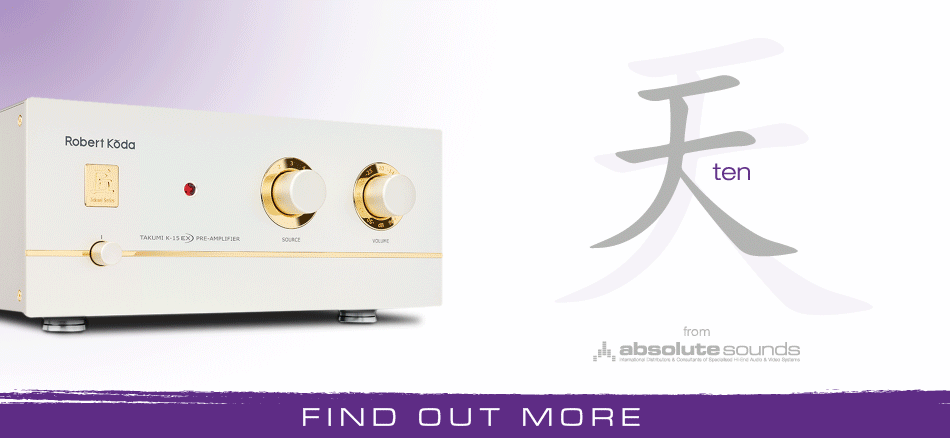


![20231227_140011[1] copy 4.jpg](/media/14554/20231227_140011-1-copy-4.jpg?anchor=center&mode=crop&rnd=133524909440000000&preset=articleBigImageHeader)
